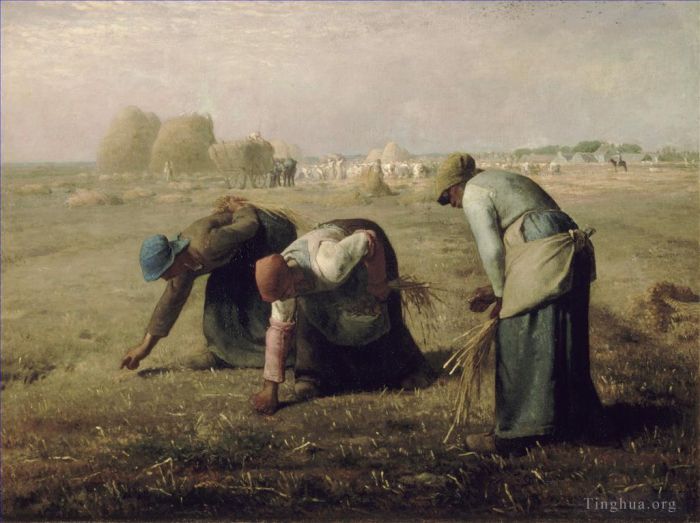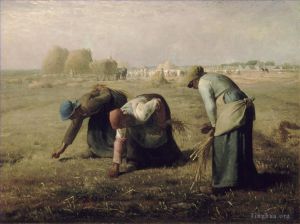The Gleaners
Jean-Francois Millet
- Price: Price on Request
- Art Type: Oil Painting
- Size:
- English Comments: 0
- International Comments: 0
- Creating Date:
- Introduction and Works of Jean-Francois Millet >>
Keywords:
Gleaners
Work Overview
- The Gleaners
Jean-François Millet (1814-1875)
1857
Oil on canvas
H. 83.5; W. 110 cm
(Musée d'Orsay) / Jean Schormans
True to one of Millet's favourite subjects – peasant life – this painting is the culmination of ten years of research on the theme of the gleaners. These women incarnate the rural working-class. They were authorised to go quickly through the fields at sunset to pick up, one by one, the ears of corn missed by the harvesters. The painter shows three of them in the foreground, bent double, their eyes raking the ground. He thus juxtaposes the three phases of the back-breaking repetitive movement imposed by this thankless task: bending over, picking up the ears of corn and straightening up again.
Their austerity contrasts with the abundant harvest in the distance: haystacks, sheaves of wheat, a cart and a busy crowd of harvesters. The festive, brightly lit bustle is further distanced by the abrupt change of scale.
The slanting light of the setting sun accentuates the volumes in the foreground and gives the gleaners a sculptural look. It picks out their hands, necks, shoulders and backs and brightens the colours of their clothing.
Then Millet slowly smudges the distance into a powdery golden haze, accentuating the bucolic impression of the scene in the background. The man on horseback, isolated on the right, is probably a steward. In charge of supervising the work on the estate, he also makes sure that the gleaners respect the rules governing their task. His presence adds social distance by bringing a reminder of the landlords he represents. Without using picturesque anecdotes, merely through simple, sober pictorial procedures, Millet gives these certainly poor but no less dignified gleaners an emblematic value free of any hint of miserabilism.
The Gleaners (Des glaneuses) is an oil painting by Jean-François Millet completed in 1857.
It depicts three peasant women gleaning a field of stray stalks of wheat after the harvest. The painting is famous for featuring in a sympathetic way what were then the lowest ranks of rural society; this was received poorly by the French upper classes.
Millet's The Gleaners was preceded by a vertical painting of the image in 1854 and an etching in 1855. Millet unveiled The Gleaners at the Salon in 1857. It immediately drew negative criticism from the middle and upper classes, who viewed the topic with suspicion: one art critic, speaking for other Parisians, perceived in it an alarming intimation of "the scaffolds of 1793."[1] Having recently come out of the French Revolution of 1848, these prosperous classes saw the painting as glorifying the lower-class worker.[1] To them, it was a reminder that French society was built upon the labor of the working masses, and landowners linked this working class with the growing movement of Socialism.[2] The depiction of the working class in The Gleaners made the upper classes feel uneasy about their status. The masses of workers greatly outnumbered the members of the upper class. This disparity in numbers meant that if the lower class was to revolt, the upper class would be overturned. With the French Revolution still fresh on the minds of the upper classes, this painting was not perceived well at all.
Millet's The Gleaners was also not perceived well due to its large size, 33 inches by 44 inches, or 84 by 112 centimetres This is huge for a painting depicting labor. Normally this size of a canvas was reserved for religious or mythological style paintings. Millet's work did not depict anything religiously affiliated, nor was there any reference to any mythological beliefs. The painting illustrated a realistic view of poverty and the working class. One critic commented that "his three gleaners have gigantic pretensions, they pose as the Three Fates of Poverty...their ugliness and their grossness unrelieved."[3] While the act of gleaning was not a new topic—representations of Ruth had existed in art—this new work was a statement on rural poverty and not Biblical piety:[3] there is no touch of the Biblical sense of community and compassion in the contrasting embodiments of grinding poverty in the foreground and the rich harvest in the sunlit distance beyond. The implicit irony was unsettling. After the Salon, Millet, short on money, sold his piece for 3,000 francs—below his asking price of 4,000[4]—after haggling with an Englishman named Binder who would not budge for his meagre counter-offer; Millet tried to keep the miserable price a secret.[5] While The Gleaners garnered little but notoriety during his life, after his death in 1875, public appreciation of his work steadily broadened. In 1889, the painting, then owned by banker Ferdinand Bischoffsheim, sold for 300,000 francs at auction.[4] The buyer remained anonymous, but rumours were that the painting was coveted by an American buyer. It was announced less than a week later that Champagne powerhouse Jeanne-Alexandrine Louise Pommery had acquired the piece, which silenced gossip on her supposed financial issues after leaving her grapes on the vines weeks longer than her competitors.
At Madame Pommery's death in 1891, and following the conditions of her will, the painting was donated to the Louvre.[4] It now resides in the Musée d'Orsay in Paris.
The Gleaners is one of Millet's best known works. Its imagery of bending peasant women gleaning was paraphrased frequently in works by younger artists such as Pissarro, Renoir, Seurat, and van Gogh.[7] Art historian Robert Rosenblum says Millet's painting introduced "imposing new presences in the repertory of mid-century art, with endless progeny in city and country. Daumier's and Degas's laundresses, and even more so Caillebotte's floor-scrapers, are almost unthinkable without Millet's epic hymn to labor."[8]
The Gleaners provides evidence of Millet's role as a contemporary social critic. His brutal depiction of three hunched, female paupers segregated from the laborers and the abundant crop in the distance demonstrates his attention to, if not necessarily sympathy for, the plight of the poorest members of the community around Barbizon and its larger neighbor, Chailly, as the area experienced the growing pains of French modernization. Only about thirty-five miles from the French capital (whose population doubled between 1831 and 1851), the rich, broad plain bordering the forest of Fontainebleau was among the earliest with a rail link to Paris, readily lending itself to feeding the burgeoning city. Studies tracing the transformation of rural France in the nineteenth century note that little change in peasant life occurred beyond northern France and the Paris basin until the last quarter of the century. Millet's representation of class strife on a large-scale farm was thus uniquely modern in the 1850s.[9]
The painting inspired the name of the Gleaner Manufacturing Company.[citation needed] The painting inspired, and is discussed in, the film by Agnes Varda, The Gleaners and I.
----------------------
Three peasant women gather grains from what's left at the end of a harvest day as the evening shadows gather around them. In the background, a horse-drawn cart full of wheat, haystacks, sheaves of wheat, a man on horseback, a village, and a large crowd of laborers depict the abundance of the harvest.
In Millet's day French farmers followed the Biblical injunction to leave gleanings (or left-over scraps of the grain harvest) in the fields so that poor women and children could live on them. Millet's Gleaners occupy the extreme foreground of the canvas. The grinding poverty of the peasant women, evident in their rough, simple garments, and the back-breaking work of collecting individual grains appear as a contemporaneous depiction of the Biblical directive. Shown at the 1857 Salon, the painting was criticized for its depiction of rural poverty. One reviewer said, "These are homely scarecrows set up in a field: M. Millet's ugliness and vulgarity have no relief."
The painting is dominated by the sculptural figures of the three women. Arms extending toward the ground, the emphasized lines of their shoulders and backs convey the strain of the arduous work. Each woman is depicted engaged in a specific task; one searches for stray grain on the ground, one collects the grains and the third ties them all together. Their faces are hidden, suggesting a sort of homogeneous anonymity rather than individuality. As with The Sower, that anonymity allows them to represent all of the poverty-stricken peasants of France, rather than simply these women. The contrast between the shadows lengthening around the women and the illuminated background where the harvesters are celebrating conveys the distinction between poverty and plenty. The distant steward on horseback, supervising the harvest, represents social order and the privilege of distance from hard labor. The leavings of grain, scattered on the ground, glisten like jewels against the drab color of the ground, yet the viewer cannot help but realize how meager they really are, and how much effort the women must make to simply live. Even so, despite their straightened circumstances, Millet bestows a certain dignity upon them. They display a measure of quiet fortitude amidst the monotony of their efforts, and despite the simplicity of their garb, their figures are robust, accustomed to the rigors of their working life.
Les Glaneuses, painted in 1857, was also meant as a social criticism. Three peasant woman in the foreground are working hard, and Millet depicts them as holy and dignified by bathing them in a bright light. These women are also close to the same color as the ground, making them appear closer to God than the upper class, which appears faintly in the background. These women represent the struggle of the working class, which works to collect what little the upper class has left for them.
- Copyright Statement:
All the reproduction of any forms about this work unauthorized by Singing Palette including images, texts and so on will be deemed to be violating the Copyright Laws.
To cite this webpage, please link back here.
- >> English Comments
- >> Chinese Comments
- >> French Comments
- >> German Comments
- >>Report
- The Walk to Work Le Depart pour le Travail
- Autumn Landscape with a Flock of Turkeys
- Norman Milkmaid
- Harvesters Resting Ruth and Boaz
- Faggot Carriers
- Portrait of a Man
- The Angelus
- Leconte de Lisle
- Pastures In Normandy
- Vert The Nuns Parrot
- Woman with a Rake
- Shepherdess with Her Flock
- Dandelions
- In the Garden
- Peasant Spreading Manure
- Landscape With Two Peasant Women
- Couseuse Endormie
- Louise Antoinette Feuardent GTY
- Garden TGT
- Portrait Of Eugene Canoville
- Man with a Hoe
- Spring
- Haystacks Autumn
- The Sower
- The Gleaners
- The Bather
- Young Woman
- Un Tailleur De Pierres
- Composition de F Millet
- Landscape Hillside in Gruchy Normandy
- Portrait Of A Man Said To Be Leopold Desbrosses
- The Drunkeness Of Noah
- The Flight into Egypt
- Fishermen
- Shepherdesses Seated In The Shade
- Femme Etandant Sonlinge
- A Shepherdess And Her Flock
- Garden Scene
- Le Nourrisson or Lenfant Malade
- Bucheron Preparant Des Fagots









 Singing Palette
Singing Palette